The Atoms for Peace Galaxy is a peculiar galaxy located approximately 220 million light-years away in the constellation Aquarius. With an apparent magnitude of 12.7 and an apparent size of 1.9 by 1.6 arcminutes, it can be seen in amateur telescopes. The galaxy is listed as NGC 7252 in the New General Catalogue.
NGC 7252 is the product of an interaction between two gas-rich spiral galaxies that has been going on for about a billion years. The galaxies are in an advanced stage of merger, with a single-nucleus merger remnant and vast tidal tails spread in different directions.
The Atoms for Peace Galaxy is formed by a pair of colliding galaxies that will eventually merge into a single larger galaxy. In a few billion years, it will look like a large elliptical galaxy with an inner disk. Astronomers have detected X-ray emissions from the galaxy, indicating the presence of an intermediate-mass black hole or nuclear activity at the centre of the galaxy.
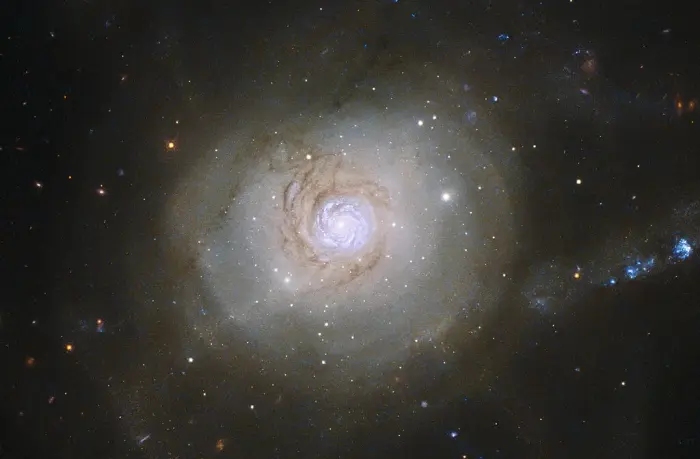
The stunning Atoms for Peace galaxy was given its nickname due to its superficial resemblance to an atomic nucleus, surrounded by the loops of orbiting electrons. “Atoms for Peace” was the title of a speech given by President Eisenhower in 1953, in an attempt to rebrand nuclear power as a tool for working toward global peace. Somewhat ironically this galaxy has had anything but a peaceful past — it was formed in a merger between two smaller galaxies nearly 1 Gyr ago. Image credit: NASA & ESA, acknowledgement: Judy Schmidt (Geckzilla) (CC BY 4.0)
NGC 7252 contains a pinwheel-shaped disk about 10,000 light-years across in its central region. The disk is the remnant of the galactic merger. The mini-spiral was once believed to rotate in the opposite direction to the rest of the galaxy. However, observations with the Visible Multi-Object Spectrograph on the European Southern Observatory’s Very Large Telescope (VLT) in 2018 allowed astronomers to measure the motion of the gas in the disk and to map its rotation. They found that the disk and the rest of the galaxy were rotating in the same direction.
The interaction between the two spiral galaxies has triggered a burst of star formation in the central region of NGC 7252. The galaxy harbours over 500 exceptionally massive and luminous young star clusters.
The most prominent of these clusters, labelled W3, is the most luminous super star cluster discovered to date. It has a mass of 80 million Suns and an estimated age of 300 – 500 million years. The young cluster has similar properties to ultra-compact dwarf galaxies.
Other luminous blue clusters in the inner region of the galaxy have estimated ages of 650 to 750 million years, which roughly corresponds to the time after the start of the merger.
The two extended tidal tails, a complex arrangement of filaments, and giant loops of stars and gas that surround the central portion of NGC 7252 make the galaxy peculiar. The galaxy is listed as Arp 226 in American astronomer Halton Arp’s Atlas of Peculiar Galaxies (1966). Arp listed the object as an example of a galaxy with amorphous spiral arms.
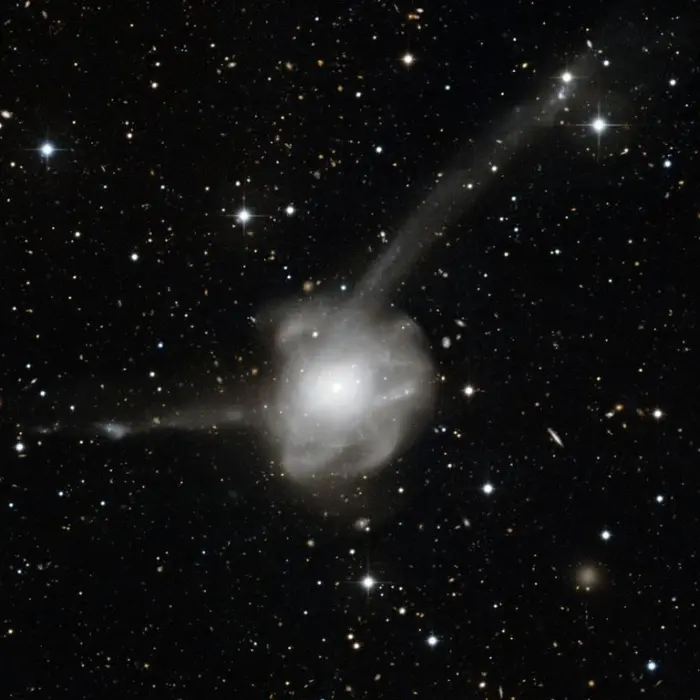
This image shows the results of a vast collision between two galaxies. This strange object is known as NGC 7252, or Arp 226, and has the odd nickname Atoms-for-Peace. The picture was taken by the Wide Field Imager on the MPG/ESO 2.2-metre telescope at ESO’s La Silla Observatory in Chile. It is a combination of exposures taken through blue and red filters, for a total exposure time of more than four hours. The field of view is about 18 arcminutes across. Credit: European Southern Observatory (ESO) (CC BY 4.0)
The elongated tails of NGC 7252 are sites of ongoing star formation. They host tidal dwarf galaxies (TDGs), gas condensations that are similar to dwarf galaxies. These condensations form within the debris of colliding galaxies and are gravitationally bound to the host galaxy.
The tidal dwarf galaxies in NGC 7252 have high metallicities, indicating that they are not dwarf galaxies caught up in the merger, but that they are currently forming out of the material expelled from the two merging galaxies.
NGC 7252 shows that two disk galaxies can be transformed into a single larger elliptical galaxy on a relatively short timescale. Galaxies like NGC 7252 help astronomers study galaxy formation and evolution in different environments, as well as the evolution of star formation in the process of galactic collisions.
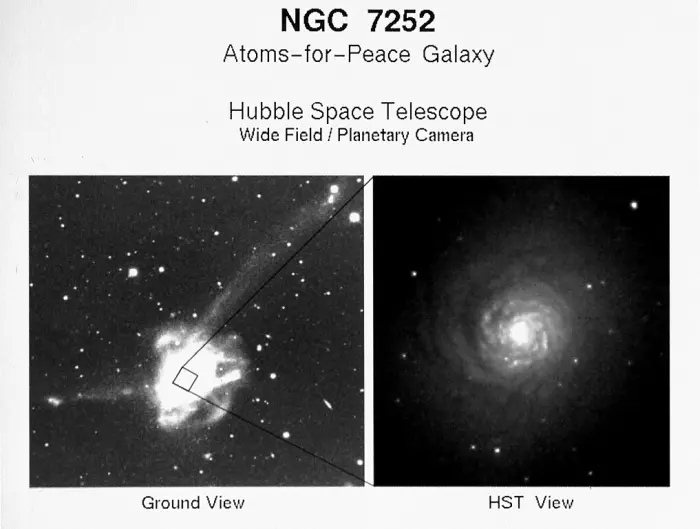
[Left] Ground-based Telescopic Photograph NGC 7252 has been considered the prototypical example of a merger between two disk-shaped galaxies. The galaxy has a pair of long tails that are unambiguous evidence of the effects of gravitational tidal forces from a galaxy merger. The galaxy is nicknamed the “Atoms-for-Peace” galaxy because its stars form a bizarre loop-like structure that resembles a schematic diagram of electrons orbiting an atomic nucleus. (In December 1953, U.S. President Dwight 0. Eisenhower made his “Atoms for Peace” speech to foster peaceful applications of nuclear energy.) Left image: Dr. Francois Schweizer, taken with 4-meter telescope at the Cerro Tololo Inter-American Observatory.; Right Image: B. Whitmore (STScI), and NASA; Co-investigators: Francois Schweizer of the Carnegie Institution of Washington, Washington, D.C., and Claus Leitherer, Kirk Borne, and Carmelle Robert of STScI. (PD)
Facts
The Atoms for Peace Galaxy was discovered by the German-British astronomer Sir William Herschel on October 26, 1785. Herschel described the object as a “very faint nebula” and listed it as III 458 in his catalogue.
NGC 7252 has been nicknamed the Atoms for Peace Galaxy because of its curious shape. The galaxy’s loop-like appearance is reminiscent of the diagram of an electron orbiting an atomic nucleus.
The galaxy’s shape is similar to the logo of the U. S. President Dwight D. Eisenhower’s “Atoms for Peace” program. President Eisenhower gave his famous “Atoms for Peace” speech at the UN General Assembly in New York on December 8, 1953. The speech held significance to the scientific community and its name was given to the peculiar galaxy.
The Atoms for Peace Galaxy appears similar to the peculiar galaxy NGC 7727, also located in the constellation of Aquarius. Like NGC 7252, NGC 7727 is the product of a galactic merger. However, it contains two galactic nuclei, each with a supermassive black hole, while NGC 7252 harbours only one.
Location
The Atoms for Peace Galaxy lies in the southern part of Aquarius, in the same region as the Helix Nebula (NGC 7293). The galaxy appears near the imaginary line connecting Fomalhaut in the constellation Piscis Austrinus and Nashira in Capricornus. It can be seen by amateur astronomers, but it is best observed in medium to large telescopes.
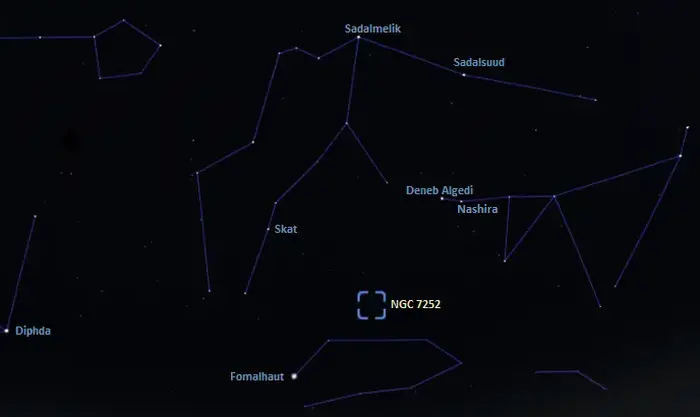
The location of the Atoms for Peace Galaxy (NGC 7252), image: Stellarium
At declination -24° 40’, NGC 7252 is visible from locations south of the latitude 65° N. The best time of the year to see the Atoms for Peace Galaxy and other deep sky objects in Aquarius is during the month of October, when the constellation appears higher in the sky in the early evening.
Atoms for Peace Galaxy – NGC 7252
| Constellation | Aquarius |
| Object type | Peculiar galaxy |
| Morphological type | (R)SA(r)0 |
| Right ascension | 22h 20m 44.7748209648s |
| Declination | −24° 40′ 41.909518200″ |
| Apparent magnitude | 12.7 |
| Apparent size | 1′.9 × 1′.6 |
| Distance | 220 million light-years |
| Redshift | 4,792 ± 1 km/s |
| Names and designations | Atoms for Peace Galaxy, NGC 7252, PGC 68612, LEDA 68612, Arp 226, ESO 533-15, AM 2217-245, ESO-LV 533-0150, IRAS 22179-2455, IRAS F22179-2455, MCG-04-52-036, 2MASX J22204475-2440420, PRC D-35, SGC 221758-2455.8, LDC 1516 J222044.75-2440420, 2RXP J222044.6-244041, Gaia DR2 6625720570070068992, Gaia DR3 6625720570070068992 |
Images
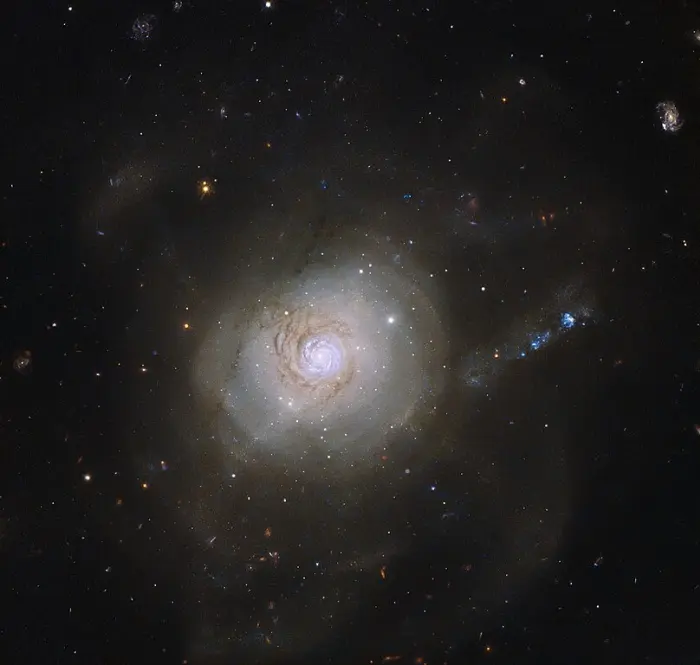
Only rarely does an astronomical object have a political association. However, the spiral galaxy NGC 7252 acquired exactly that when it was given an unusual nickname. In December 1953, the US President Dwight D. Eisenhower gave a speech advocating the use of nuclear power for peaceful purposes. This “Atoms for Peace” speech was significant for the scientific community, as it brought nuclear research into the public domain, and NGC 7252, which has a superficial resemblance to an atomic nucleus surrounded by the loops of electronic orbits, was dubbed the Atoms for Peace galaxy in honour of this. These loops are well visible in a wider field of view image. This nickname is quite ironic, as the galaxy’s past was anything but peaceful. Its peculiar appearance is the result of a collision between two galaxies that took place about a billion years ago, which ripped both galaxies apart. The loop-like outer structures, likely made up of dust and stars flung outwards, but recalling orbiting electrons in an atom, are partly responsible for the galaxy’s nickname. This NASA/ESA Hubble Space Telescope image shows the inner parts of the galaxy, revealing a pinwheel-shaped disc. This disc resembles a spiral galaxy like our own galaxy, the Milky Way, but is only about 10 000 light-years across — about a tenth of the size of the Milky Way. It is believed that this whirling structure is a remnant of the galactic collision. It will most likely have vanished in a few billion years’ time, when NGC 7252 will have completed its merging process. Image credit: NASA & ESA, Acknowledgements: Judy Schmidt (Geckzilla) (CC BY 4.0)
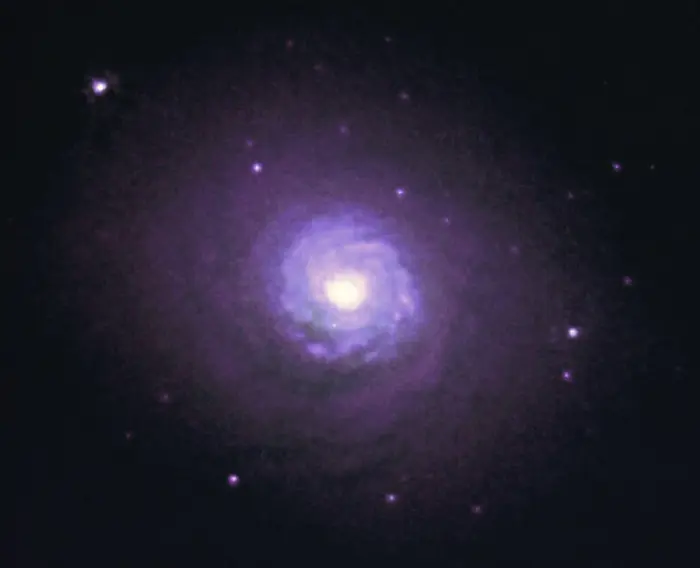
A NASA Hubble Space Telescope (HST) image of the core of the peculiar galaxy NGC 7252 reveals a striking “mini-spiral” disk of gas and stars, and about 40 exceptionally bright and young globular star clusters. The visible light image was taken with the Wide Field and Planetary Camera (WFPC) in PC mode, on October 10, 1992. The false-color image has been subject to computer image reconstruction. The strong spiral structure is 10,000 light-years across (7 arc seconds); the entire picture is 46,000 light-years across. Hubble’s resolution is so good the astronomers can measure the diameters of the clusters (0.04 arc seconds, the apparent size of a dime at a distance of 60 miles). They turn out to be about 60 light-years in diameter, the same size as globular clusters that orbit our Milky Way galaxy. The globular star clusters are concentrated near the galaxy’s core. Estimated to be mostly between 50 and 500 million years old, they were apparently born following the collision of two disk-shaped galaxies about a billion years ago. The pinwheel-shaped disk of gas and young stars has an uncanny resemblance to a face-on spiral galaxy. Yet the disk is only 1/20 the diameter of the total galaxy. The disk was probably fueled by the collision. The globular clusters found in NGC 7252 are considered the progenitors of globular clusters that orbit our own Milky Way galaxy. This discovery provides some of the best evidence to date for solving more than half a century of theory and conjecture about how giant elliptical galaxies form. Image credit: B. Whitmore (STScI), and NASA Co-investigators: : Francois Schweizer of the Carnegie Institution of Washington, Washington, D.C., and Claus Leitherer, Kirk Borne, and Carmelle Robert of STScI (PD)
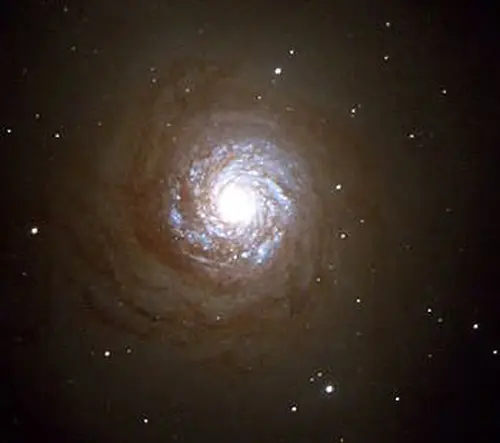
Atoms for Peace Galaxy captured by the Hubble Space Telescope, image credit: NASA/ESA, Hubble (PD)